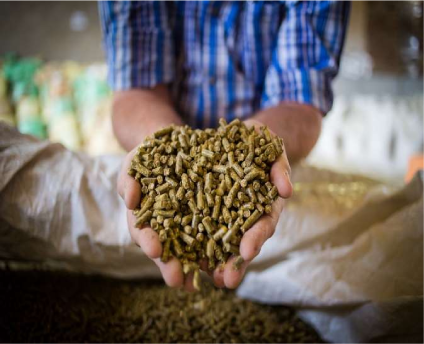
Peter Njeri 
Master’s in Agriculture with IT – Maseno University
Did you know you can use waste products to make organic fertilizers and produce animal
feeds? You heard me right! Yes, waste products can create animal feeds too. That sounds like a
great deal! It is. Is the cost of providing your animals and poultry a challenge? Do you want a
high-quality feed? Are you wondering where and how you can get cheap animal feed? Using
waste products to make your feeds solves your problems. Like you, your livestock needs a
balanced diet that contains all the required nutrients, minerals, fluids, and vitamins. Providing
your animals with good nutrition ensures they grow, develop, reproduce and have strong
immunity to fight diseases. Put together; the overall outcome is more profitable and sustainable
agriculture
It doesn’t matter what you feed your animals, be it commercial feeds or farm products;
what is important is that the ration meets the essential needs of each animal. The critical
requirements in livestock vary from one stage to another. For example, a pig’s nutritional needs
differ from those of cattle. Similarly, a lactating cow’s dietary needs differ from a calf’s. The cost
of animal feeds the center of ensuring that your animals grow, develop, reproduce, and have
strong immunity. The cost of animal feed and its supplements has proved to be a significant
challenge. This is associated with the high cost of producing commercial feeds. Most farmers
feed their livestock with proteins obtained from soya beans and fish meal, whose production
increases pressure on the environment. In the last year, the cost of feeds has shot from sh.65 per
kg to sh130; this is associated with the increase in fuel prices, which has consequently increased
the price of maize and raw materials for manufacturing animal feeds. Feed’s protein costs
account for 60 to 70 percent of the total production cost of raising animals; farmers have now
been left with the option of making their animal feeds. This is, in fact, a good option.
Why do you need to produce your animal feeds? With the cost of commercial feeds
rising, manufacturing your fodder is a better way to minimize cost and maximize production.
This is made possible by the availability of raw materials. Food waste is the most significant
contributor to municipal landfills; it generates gaseous substances, which are very potent
greenhouse gases. Converting food waste to animal feeds is not only cost-effective but also ecofriendly. Similarly, such feeds are richer in proteins than adulterated feeds, which threaten dairy
cattle and other animals.
Companies producing such feeds collect raw materials from hotels, restaurants, and
schools. Such waste is converted into animal feed through the production of protein-rich larvae
of the black soldier fly. The production begins with the breakdown of the waste into small
particles, which can be fed to the flies. Upon processing, the waste is taken to a different place
where the flies are introduced to lay eggs, and after hatching, the larvae feed for at least seven
days. The larvae are moved to other trays, where they feed for two more weeks and are
subsequently separated, dried, and packed as animal protein. In the process, organic fertilizers
are produced from the larvae manure
The most significant advantage of producing your animal feeds is that the insects can
transform the waste into high-quality protein for your livestock within a short time. Furthermore,
such feeds are inexpensive and clean and offer a sustainable food source when the economy is
struggling to remain afloat and the cost of living is so high. Additionally, using such feeds
increases production, which means quality products. The sole dependence on soybeans and fish
meal creates competition between the farmer and the livestock. This is because they are also
human food. The use of larvae animal protein means that there are solely for animal consumption
and the farmer no longer needs to debate between feeding himself and feeding the livestock.
At Alkebulan, instead of using insects to
manufacture animal feeds, our feed is the
residue produced in manufacturing briquettes.
This residue is blended with Sugar Molasses and
fortified with Immunity Booster medicines
which now goes back to the farmers. The fodder
is rich in nutrients for domesticated cattle.
How readily available are these feeds in the market? Many recycling companies have
taken advantage of the new opportunities that innovation seeks to offer. Such feeds are thus
readily available in the markets. Save for being readily available; the feeds are also very
affordable. While a kilogram of fish meal costs Ksh.160, the animal protein is sold at Ksh. 100
per kilogram. What a great way to reduce the cost spent on buying adulterated feeds. Farmers
will be able to save Ksh. 60 when formulating their animal feeds. Feeding livestock on the larvae
proteins will enhance growth performance, carcass yield, meat, and dairy quality. Using the
larvae as a naval protein source for your animals is an excellent substitute for costly fishmeal and
soya bean meal.

How, then, can you make your animal feed? Companies such as our company that recycle
waste products sell the same and provide training to farmers to make their animal feeds. What
better way to encourage farmers and promote a sustainable future than training them to make
their feeds; farmers become more motivated, and food industries are encouraged to supply food
waste. The availability of raw materials should be an opportunity that every farmer should seek
to exploit. Why do you need to compete with your livestock for soya beans and fish meals if you
can quickly provide them with feeds that are strictly for them? Taking advantage of this
opportunity will not only be cost-effective but also a move towards ensuring that your livestock
has the best nutrients for their growth, development, and immunity. By producing your feeds,
you ultimately participate in the common goal of maintaining a safer environment for yourself
and your livestock. Who doesn’t want that? Not you.
References
Kithi, M. (2021, 8). How firm uses flies to turn waste into cheap animal feed. Retrieved from: https://www.businessdailyafrica.com/bd/data-hub/expensive-fertiliser-pushes-farmers-to-organic-farming-3790004
Latest News, Western Kenya dairy farmers bank on brewery waste to save Sh50, 000 animal feed costs a month. Retrieved from: https://farmbizafrica.com/profit-boosters/2798-western-kenya-dairy-farmers-bank-on-brewery-waste-to-save-sh50-000-animal-feed-costs-a-monthhttps://kilimoinsight.co.ke/turn-your-kitchen-waste-into-manure/

